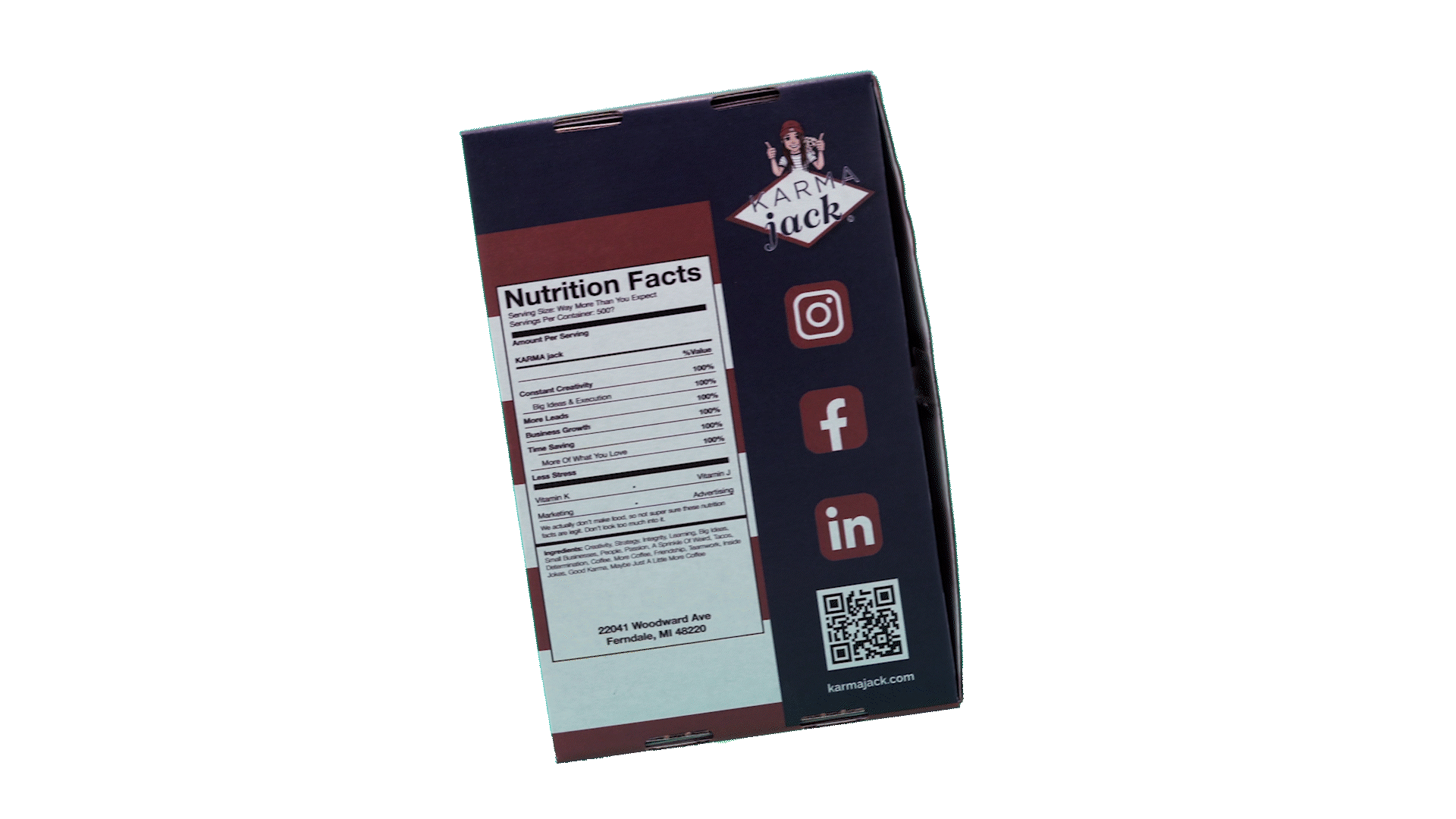Creative & Digital Marketing Agency | KARMA jack
Good Karma,
Better Marketing
Creativity Meets Digital Marketing Excellence
50+ Reviews
Generate more leads
Using the top advertising and marketing agency in Michigan will drive your ideal audience right to you.
Gain more customers
We know what it takes to expand your business and get more customers buying your awesome products and services.
Grow your business
Our digital marketing experts handle everything from Social Advertising to SEO for websites. It’s time to grow.
We Offer
Advertising
We use the best marketing mixes of social media ads while advertising with Google & YouTube.

We Offer
Advertising
We use the best marketing mixes of social media ads while advertising with Google & YouTube.

We Offer
consulting
When we say digital marketing consulting, we mean we consult you on everything. From updating websites, social ads, being more searchable, increasing traffic, gaining leads and revenue, to overall getting a return on ad spend.

No copy and paste bullsh*t marketing like everyone else.
We’re internet marketing scientists. Constantly testing new, experimental approaches to find out what works and what doesn’t. Then, we bring what works to you to get RESULTS. What’s the point of hiding your business in the shadows? Why plateau when you can grow?

See how we've helped
Hundreds of Companies Grow

Next Level Digital Marketing Lead Generation
There’s no such thing as a free lunch, but believe it or not, there is such a thing as a remarkable digital marketing team. This includes a devoted account manager leading a team of experts in every channel providing trackable results for less than the cost of one entry level employee.
KARMA jack's Approach to Internet Marketing
It takes hard work, not magic, to do what we do.
Our agency of digital marketing experts deliver the results you deserve.
- Research
- Strategy
- Execution
- Analyze & Adjust
First, we learn about you and your business.
Just like the business owners themselves, we’re well aware that every company has different needs. The copy and paste approach doesn’t cut it when it comes to effective advertising. We’ve seen time and time again that inauthenticity leads to brick wall results. So we pull from our conversations, competitive data, and create something special. Our goal: data-driven business growth!
Customized digital marketing strategy!
After we talk to you about your business, our whole team puts our heads together to create a completely customized marketing strategy. When we’re handling everything from SEO to Facebook advertising to email marketing, we make sure each service is being operated by an expert in the field. We pull from previous data, industry trends, and your story to craft something that works. It’s time to get you more customers and a solid stream of leads!
We flip the switch and start the show!
This part is always exciting. We see the marriage of analytics and creative come together into Google Ads, Facebook Ads, Email Marketing, SEO blogs and websites, Social Media, and even creative projects like professional photography and videos. All of this done with purpose, not just a cosmetic reason. We want to set a solid foundation for you to get exclusive leads, more customer and grow your business.
Think that was it? Nope! Digital Marketing is an ongoing process to get great results!
The fun doesn’t end there. We’ve been getting our clients a great ROI because we relentlessly check data and adjust to make sure we’re always growing. Just like the social media landscape, advertising trends are constantly changing. Our job is staying ahead of them so you see the benefits! Now let’s grow together.
What are you worrying about?
We’re honestly very nice.
"One of the best investments"
Karma jack continues to impress me with their availability to meet with me and the promptness of answering my requests/questions. If you are serious about growing your business and getting the right clients you need to hand over your digital marketing to Karma jack.
Anthony M.
"Always going the extra mile for us."
KJ is an agency that does their best to make their customers feel like family and pushes through the work quickly and in a very cost-effective manner, without sacrificing quality. Web development, SEO, copywriting, social advertising, creative development, and a strong understanding of all that Google has to offer is the reason we continue to lean on our friends at Karma Jack.
Christian S.
"They are rockstars!"
An incredible bunch of talented professional work here! Look no further for your marketing needs. I’ve worked with other companies before an no one compares to Karma. They take the time to know your product and continuously adjust to make sure whatever your company does, they fully understand how to achieve the best results.
Peter M.
KARMA jack partners with Chevrolet Detroit Grand Prix presented by Lear
We are thrilled to announce KARMA jack’s social media partnership with the Chevrolet Detroit Grand Prix presented by Lear. Having the opportunity to tell the story of the Motor City and this electrifying event is a dream come true.
We want to give a huge thanks to our new friends at Gardner White for powering the initiative. Now we can use our creativity to connect the community and attract new fans to this life-changing event.
Connect With Your Dream Audience
We want you to play to the biggest crowd of your life. Like Queen at Live Aid.
So it’s time we hand you the microphone and let you shine.
Everyone Says "One-Stop-Shop" But I Mean...

Social Ad Masterminds
Facebook, Instagram, YouTube, LinkedIn, all of it. Social media advertising is MASSIVE.

Impactful
Websites
Whether it's updating or building from scratch, we want your website to be your favorite place on the internet.

On Trend
Social Media
Our team creates content and schedules posts so you can keep growing your company.

Timeless
Branding
Build your brand awareness with our digital marketing agency experts.

Brand Defining
Photo & Video
Our creative team has access to content professionals around the country to handle your niche needs.

Grow Hack Consulting
Our marketing experts will work with you to grow your business with our experience.

Google
Advertising
We utilize Google's vast platform to make your business more searchable and profitable.

Artificial
Intelligence (AI)
Connecting with your target audience using AI technology to reduce costs.
The KARMA jack Process
1
Fill Out The Form
Interested in working with us? We get it. Just fill out the form and we'll get back to you. No presh.
2
Let's Dig In
We chat, analyze, and give you a ton of advice. Then we talk pricing. If it makes sense for you, we roll.
3
Launch Your Strategy
Once we shake hands, we build a comprehensive strategy, you approve, then we start the real work.

We Want To See You Succeed
(No, Really)
You worked your whole career for this, now. . .
● Stay ahead of your competition.
● Reduce wasted spend.
● Get continuous expert advice.
● Clearly understand your marketing.
● Receive full transparency and reporting.
● Adapt and evolve with purpose.
● Expect absolutely ZERO B.S.
● Brag to your friends. Because you can.
Contact Us
Reach out and we can’t wait to politely pummel you with value.






